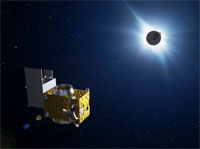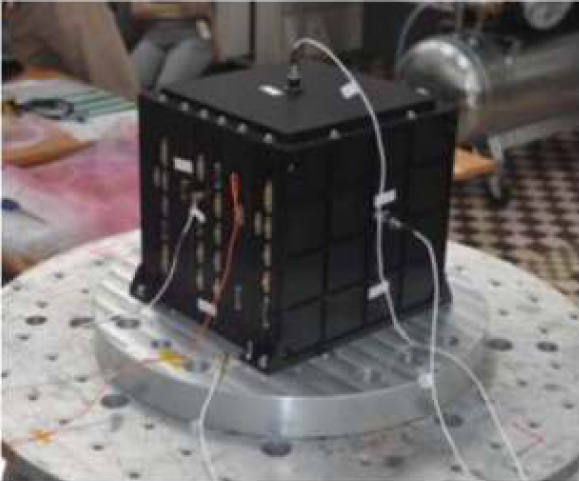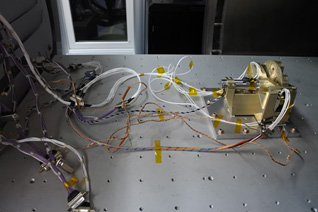- development to high technology readiness (TRL 9), and in-orbit demonstration of formation flying techniques and associated technologies,
- development and validation of the engineering approach, ground verification tools and facilities required by formation flying,
- observation of the solar corona via the implementation of a coronagraph

![]() The mission consists of two small satellites launched together that will separate apart to fly in tandem. The three-axis stabilized minisatellites will fly in a formation with relative position control accuracy of less than 1 mm. In order to complete the end-to-end validation of the formation flying technologies, a scientific instrument, a coronagraph, has been selected with the goal of taking pictures of the inner solar corona. The coronagraph system is distributed over the two satellites; one carrying the detector and the second one carrying the Sun occulter disk. The two minisatellites are referred to as CSC (Coronograph SpaceCraft) with a mass of ~340 kg and OSC (Occulter SpaceCraft) with a mass of ~200 kg.
The mission consists of two small satellites launched together that will separate apart to fly in tandem. The three-axis stabilized minisatellites will fly in a formation with relative position control accuracy of less than 1 mm. In order to complete the end-to-end validation of the formation flying technologies, a scientific instrument, a coronagraph, has been selected with the goal of taking pictures of the inner solar corona. The coronagraph system is distributed over the two satellites; one carrying the detector and the second one carrying the Sun occulter disk. The two minisatellites are referred to as CSC (Coronograph SpaceCraft) with a mass of ~340 kg and OSC (Occulter SpaceCraft) with a mass of ~200 kg.
![]() The two spacecraft will be controlled in space as if they were two parts of a rigid structure of length 150 m (e.g. telescope optics and detector). This virtual rigid structure will be commanded to rotate and point to any desired direction. It will also be possible to set the relative distance of the two spacecraft from 25 to 250 m (i.e. change the focal length).
The two spacecraft will be controlled in space as if they were two parts of a rigid structure of length 150 m (e.g. telescope optics and detector). This virtual rigid structure will be commanded to rotate and point to any desired direction. It will also be possible to set the relative distance of the two spacecraft from 25 to 250 m (i.e. change the focal length).
![]() The team from CBK is responsible for the design of Coronograph Control Box and its integration and also for Filter Wheel Assembly for Coronograph Optical Box. The responsibility includes the correctness of the implementation of the whole enterprise in terms of the requirements as well as compliance with design rules and the coordination of the work of subcontractors and acceptance for the results of their activities.
The team from CBK is responsible for the design of Coronograph Control Box and its integration and also for Filter Wheel Assembly for Coronograph Optical Box. The responsibility includes the correctness of the implementation of the whole enterprise in terms of the requirements as well as compliance with design rules and the coordination of the work of subcontractors and acceptance for the results of their activities.
![]() The Coronagraph Control Box (CCB) is the main Coronagraph Instrument controller, providing all necessary processing capabilities and power to the other scientific equipment. It is the payload control and data processing unit for Proba-3 mission. The CCB is controlled by commands from the onboard computer (ADPMS) and provides telemetry to the ADPMS. It is powered by the ADPMS.
The Coronagraph Control Box (CCB) is the main Coronagraph Instrument controller, providing all necessary processing capabilities and power to the other scientific equipment. It is the payload control and data processing unit for Proba-3 mission. The CCB is controlled by commands from the onboard computer (ADPMS) and provides telemetry to the ADPMS. It is powered by the ADPMS.

![]() The main project activities in 2018 were: manufacture and integration od the CCB Structural-Thermal Model (STM), environment testing at CBK PAN and in the Institute of Aviation, advanced boot software design and application softawe design, laboratory testing of development models of subsystems.
The main project activities in 2018 were: manufacture and integration od the CCB Structural-Thermal Model (STM), environment testing at CBK PAN and in the Institute of Aviation, advanced boot software design and application softawe design, laboratory testing of development models of subsystems.
![]() In 2016 the main project activities consisted of: detailed CCB mechanical design, thermal and mechanical (vibrations etc.) analyses, manufacturing of most of the CCB Structural-Thermal Model and preparations for environmental tests, advanced electrical sub-system design for the DPU, AEU and PCU, advanced Boot Software Design, continued development of the Application Software Design (Software PDR passed. First tests of subsystem Development Models were successful.
In 2016 the main project activities consisted of: detailed CCB mechanical design, thermal and mechanical (vibrations etc.) analyses, manufacturing of most of the CCB Structural-Thermal Model and preparations for environmental tests, advanced electrical sub-system design for the DPU, AEU and PCU, advanced Boot Software Design, continued development of the Application Software Design (Software PDR passed. First tests of subsystem Development Models were successful.
![]() Design activities, system engineering, and housing and harness manufacturing are managed and carried out at the CBK PAN, while manufacturing and some design activities are outsourced to subcontractors. N7 Mobile is contracted to CCB for software design and manufacturing; Creotech Instruments for EGSE; AEU for design and DPU manufacturing; and Astri Polska for PCU design and manufacturing. The main project activities in 2015 were: preparation and release of detailed schematics
for DPU, AEU, PCU modules and preparation and release of design descriptions for these modules.
Design activities, system engineering, and housing and harness manufacturing are managed and carried out at the CBK PAN, while manufacturing and some design activities are outsourced to subcontractors. N7 Mobile is contracted to CCB for software design and manufacturing; Creotech Instruments for EGSE; AEU for design and DPU manufacturing; and Astri Polska for PCU design and manufacturing. The main project activities in 2015 were: preparation and release of detailed schematics
for DPU, AEU, PCU modules and preparation and release of design descriptions for these modules.
![]() The Filter Wheel Assembly (FWA) is an optomechanical system situated in front of the focal plane assembly. The main task of the system is to sequentially position the different filter/ polarizers in the optical beam of the coronagraph. In 2015, the design and analysis of the Development Model was completed, and vibration and radiation tests were conducted. The report of the project's current phase was delivered to the prime contractor (CSL).
The Filter Wheel Assembly (FWA) is an optomechanical system situated in front of the focal plane assembly. The main task of the system is to sequentially position the different filter/ polarizers in the optical beam of the coronagraph. In 2015, the design and analysis of the Development Model was completed, and vibration and radiation tests were conducted. The report of the project's current phase was delivered to the prime contractor (CSL).
![]() The contract for the construction of the CCB and FWA system of ASPIICS/PROBA3 coronograph was signed on July 8, 2015 between the Centrum Badań Kosmicznych, representing the Polish site of subcontractors, and the Centre Spatial de Liège – Université de Liège. CBK will deal, in particular, with the system engineering project, development of the on-board computer, ensuring appropriate product assurance, then the design and implementation of the driver housing and internal wiring. CBK is also responsible for the integration of the CCB (in our clean-room) and for the functional tests.
The contract for the construction of the CCB and FWA system of ASPIICS/PROBA3 coronograph was signed on July 8, 2015 between the Centrum Badań Kosmicznych, representing the Polish site of subcontractors, and the Centre Spatial de Liège – Université de Liège. CBK will deal, in particular, with the system engineering project, development of the on-board computer, ensuring appropriate product assurance, then the design and implementation of the driver housing and internal wiring. CBK is also responsible for the integration of the CCB (in our clean-room) and for the functional tests.

![]() In 2019, the CBK PAN designed and manufactured a complete FWA Qualification Model that performed successfully in the qualification campaign at unit level, and was delivered to the Centre Spatial de Liège (CSL) for instrument-level testing. The Flight Model is planned to be delivered to the CSL by mid-2020.
In 2019, the CBK PAN designed and manufactured a complete FWA Qualification Model that performed successfully in the qualification campaign at unit level, and was delivered to the Centre Spatial de Liège (CSL) for instrument-level testing. The Flight Model is planned to be delivered to the CSL by mid-2020.
![]() The design and analysis of the Second Development and Test Models was completed in 2016. Both models were manufactured, assembled and vibration tests were carried out and the Test Model was delivered. Reports from the current phase of the project were prepared and delivered to the prime contractor CSL.
The design and analysis of the Second Development and Test Models was completed in 2016. Both models were manufactured, assembled and vibration tests were carried out and the Test Model was delivered. Reports from the current phase of the project were prepared and delivered to the prime contractor CSL.
![]() The integration of the whole ASPIICS coronograph is planned to be in Belgium, Liege, in 2018. The launch and the start of the 2-years mission is forseen for 2019.
The integration of the whole ASPIICS coronograph is planned to be in Belgium, Liege, in 2018. The launch and the start of the 2-years mission is forseen for 2019.
![]() In 2014 the project was in phase B - the first documents (requirements and specifications) had been prepared by the consortium for CCB (Coronograph Control Box) and delivered to ESA for PCR (Payload Consolidation Review).
In 2014 the project was in phase B - the first documents (requirements and specifications) had been prepared by the consortium for CCB (Coronograph Control Box) and delivered to ESA for PCR (Payload Consolidation Review).